What is good about the “Bush orange” pumpkin and why you should try growing it on your own plot
Orange bush pumpkin contains carotene, magnesium and phosphorus. Regular consumption of the vegetable improves immunity, and a glass of pumpkin juice at night relieves insomnia. Bush orange is valued for its beneficial properties, sweet and juicy pulp. It is used to prepare soups, salads, and side dishes.
In the article you will find a description and photo of the Orange Bush pumpkin.
Description of the variety
Grows orange bush without long vines, a small shrub, for which it received its name. In the garden bed, compact bushes take up little space, so they get a rich harvest from a small area.
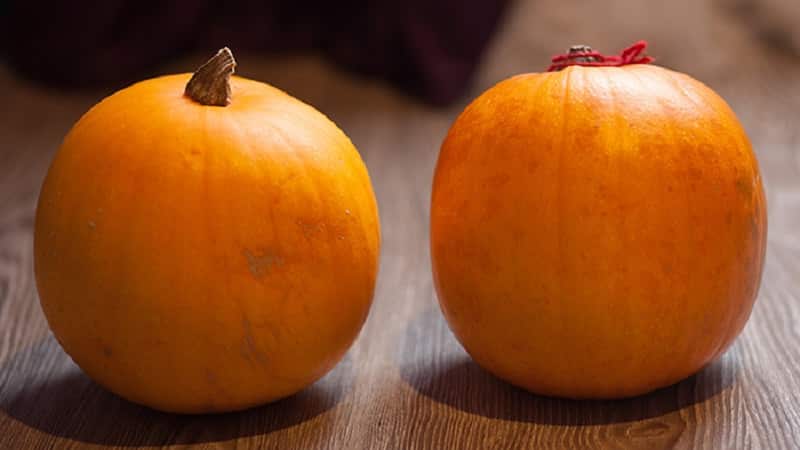
Peculiarities
Mid-season variety: Harvest 95–105 days from planting. Grow by seedlings or seeds in open ground. The bushes are miniature, the leaves are medium sized, dark green. Bush orange is planted in the south or in central Russia.
Fruit characteristics and yield
The fruits are round and firm, covered with a slightly ribbed dark orange skin.. The flesh is fleshy, the color is bright orange. Pumpkin weight: from 4 to 7 kg. The taste is pleasant, due to which the vegetable is used in cooking. Productivity is stable: from 1 m2 summer residents collect about 12–15 kg.
Interesting! The fruits of the Orange Bush are used to make the world-famous Jack-O-Lanterns - bright lanterns for Halloween. Initially, this tradition appeared in Ireland and Scotland, but soon spread to other countries.
How to grow
In the southern regions, summer residents plant pumpkin seeds in open ground in early May; in the middle zone, seedlings are prepared in early April. Let's look at the features of each method.
Seeds
For this purpose, large and heavy seeds are selected.. They are immersed in a saline solution and left for 2 hours. Empty grains will remain on the surface of the water, which are not suitable for planting. Those that have sunk to the bottom are taken out of the jar and dried.
Important! A mandatory stage of seed preparation is disinfection. It is carried out by soaking in a weak solution of potassium permanganate or Bordeaux mixture. Disinfection strengthens the plant’s immunity, protects against diseases and pests.
In the pumpkin garden, choose a mixture of loamy and sandy loam soils. The vegetable loves warmth and sun, so it is planted in southern and hilly beds. Before planting, the soil is carefully dug up, and river sand or sawdust is added as a natural leavening agent: they make the soil lighter and airier. If the soil has a high level of acidity, liming is carried out: dry lime and wood ash are added to the beds in equal parts.
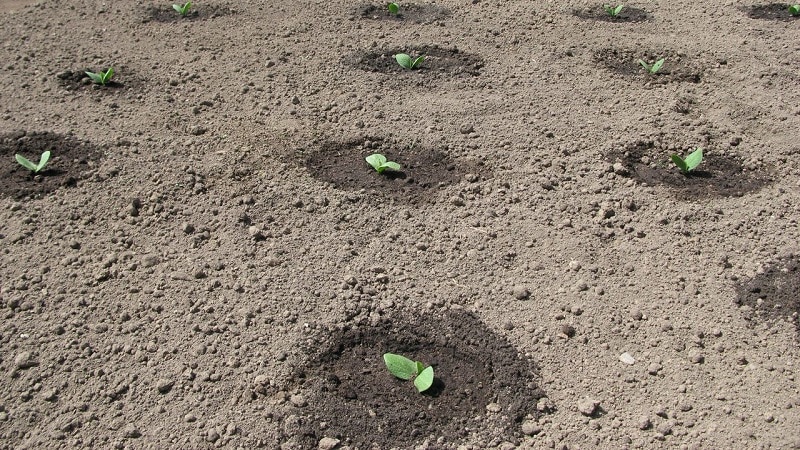
Planting scheme for bush orange - 60x60. Furrows 2-3 cm deep are made in the beds and disinfected seeds are placed in them. Sprinkle the top with loose soil and peat chips, pat down, and water generously with warm water. In the first week, the plant is covered with film to create a greenhouse effect, protection from wind and frost.
About other varieties of pumpkin:
Fleshy variety of pumpkin “Pastila Champagne” with juicy pulp
Large-fruited and mid-season pumpkin variety “Volzhskaya gray”
Seedlings
For seedlings you will need suitable containers. These can be thick plastic bags, cardboard boxes, even eggshells. Before use, wash the container with warm water and soda and wipe dry with a clean napkin. As soil, use soil from the garden, previously disinfected with a solution of succinic acid. To save time and effort, use a ready-made soil mixture from the store: it is already disinfected and saturated with nutrients.
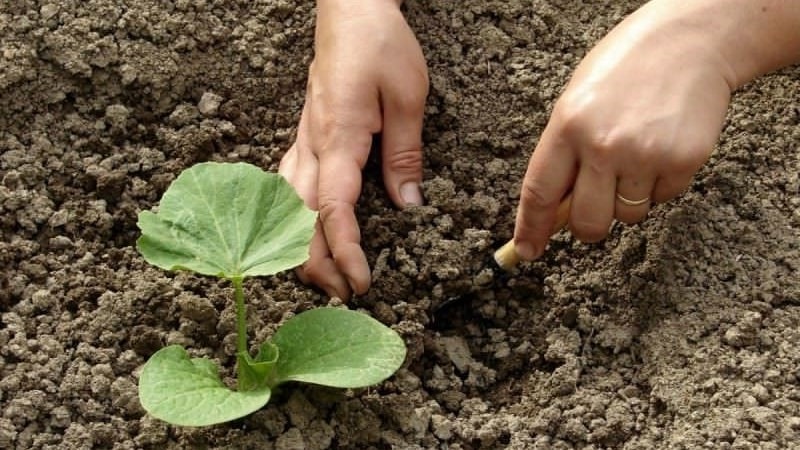
Important! To ensure that sprouts appear as quickly as possible, the seeds are germinated before planting. To do this, the disinfected material is wrapped in a damp, warm cloth and put in a sunny place. To accelerate development, the drug “Zircon” is added.
After germination, the seeds are placed in moist soil at a distance of 5–8 cm from each other. Daylight hours for growing should last at least 12 hours. Drafts are unacceptable, since the crop is sensitive to temperature conditions. Moisten the seedlings as the soil dries, once every 5–7 days. For irrigation use warm, clean water. 15 days after planting, the sprouts are fertilized with liquid mullein or bird droppings.
Care
Caring for Bush Orange consists of timely watering, fertilizing, and loosening the soil:
- Water the bushes in the early morning or evening so that the water does not evaporate in the sun. Use clean water at room temperature, replace it once a week with a solution of nettle or burdock to maintain immunity. On average, about 1.5 liters are spent per plant, but if the summer is rainy, the amount of water is reduced. It is convenient to moisten the beds using a drip system: the water gets directly under the root and is used sparingly.
 Fertilize the pumpkin with organic substances 2 weeks after planting in the ground.An excellent fertilizer for vegetables is compost or humus. Manure, plant tops, food waste, and leaves are added to the beds before watering. Don't forget about mineral fertilizers. The preparations “Kemira” and “Magic Leika” improve the quality of fruits.
Fertilize the pumpkin with organic substances 2 weeks after planting in the ground.An excellent fertilizer for vegetables is compost or humus. Manure, plant tops, food waste, and leaves are added to the beds before watering. Don't forget about mineral fertilizers. The preparations “Kemira” and “Magic Leika” improve the quality of fruits.- Loosen the soil once every 10 days. This improves the quality of the soil and prevents the occurrence of diseases and pests. It is recommended to carry out the procedure after rains to retain moisture in the ground for as long as possible.
Features of cultivation and possible difficulties
During the growing process, it is important to monitor the amount of fertilizing applied.. It is not recommended to simultaneously add fertilizers containing the same active substance - for example, ammonium nitrate and calcium nitrate. An excess of nitrogen leads to an increase in green mass, an excess of calcium leads to drying out and yellowing of the fruit.
If the pumpkins grew big and heavy, gardeners are building additional supports. These can be wooden planks, sheets of plywood or flat stones. Vegetables should not lie on the ground: this leads to the development of diseases and rotting of the fruit.
Growing tips from experienced gardeners
It is important to follow the regime of watering and fertilizing, and do not forget about loosening. Experienced farmers advise:
- plant pumpkins in beds where legumes, cabbage or herbs previously grew;
- for irrigation, use water with a temperature of at least +20 °C;
- alternate organic and mineral fertilizing;
- during the fruiting period, reduce the amount of watering by 2 times;
- When treating beds with chemicals, use gloves and a respirator.
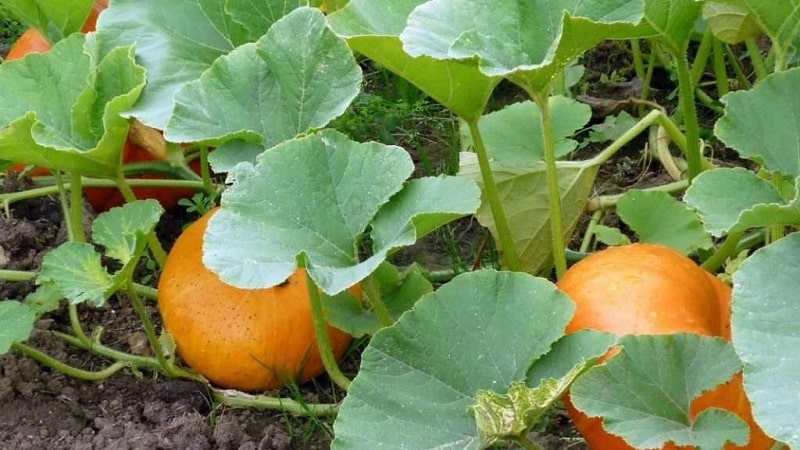
Diseases and pests
Although Orange bush is unpretentious in care, unwanted guests often appear in the beds - weeds and pests.The reasons for their occurrence lie in improper care, sudden changes in weather, and contaminated soil.
Pumpkin patches are susceptible:
- Downy mildew, which appears as brown and yellow spots on leaves and stems. The source of infection is insects or soil. To avoid the disease, it is recommended to follow the rules of crop rotation and disinfect the seeds. For treatment, the drugs “HOM” or “Zircon” are used.
- Sclerotinia - white rot. Occurs due to high humidity and excess fertilizing. Most often found in greenhouses or greenhouses. The bushes become covered with a white coating, which can be eliminated by spraying with Bordeaux mixture. For prevention, the crop is fertilized with zinc sulfate.
- Bacteriosis - the fruits become deformed, lose their firmness and elasticity. The disease occurs due to contaminated soil and weeds. If signs are detected, the fruits are picked and buried away from the garden plot.
Pests include slugs and spider mites. Insects disrupt the metabolism of plants, causing them to wither and become deformed. To prevent this from happening, the bushes are regularly inspected and sprayed with a solution of whey and iodine.
Read also:
Harvesting and application
 The orange bush harvest is harvested in August-SeptemberWhen the fruits are covered with a hard crust, they will acquire a dark orange color. Pumpkins are picked along with the stem.
The orange bush harvest is harvested in August-SeptemberWhen the fruits are covered with a hard crust, they will acquire a dark orange color. Pumpkins are picked along with the stem.
After harvesting, the vegetables are not washed, but wiped with a dry cloth: this way the crop will retain its freshness, taste and benefits longer. Store the fruits in a cellar or basement. The optimal humidity level is 80%.
Pumpkin is added to nutritious puree soups, vegetable salads, casseroles and snacks.. Low-calorie and healthy desserts are made from the pulp of Bush Orange: cakes, muffins, cheesecakes, mousses and sorbets. Enhance the taste of the product with mint, cinnamon or honey.
Interesting! 100 g of pumpkin contains more protein than 100 g of quail eggs. In terms of the amount of carotene, pumpkin overtook carrots by 5 times.
Advantages and disadvantages of the variety
The advantages of culture include juicy and sweet taste of the pulp, attractive commercial appearance, ease of care. The variety shows stable high yield. Bush orange does not need staking or shaping, which makes it more attractive to novice gardeners.
Disadvantages of the variety - average immunity to pests and diseases. Gardeners also note that Bush Orange is not suitable for growing in Siberia and the Urals.
Farmer reviews
Bush orange - a godsend for summer residents. Here's what gardeners from all over Russia say about the variety:
Maria, Moscow: “The orange bush attracts me with its appearance. Large fruits look beautiful both in the garden and on the table. I cook pumpkin dishes in the oven and add them to milk porridge.”.
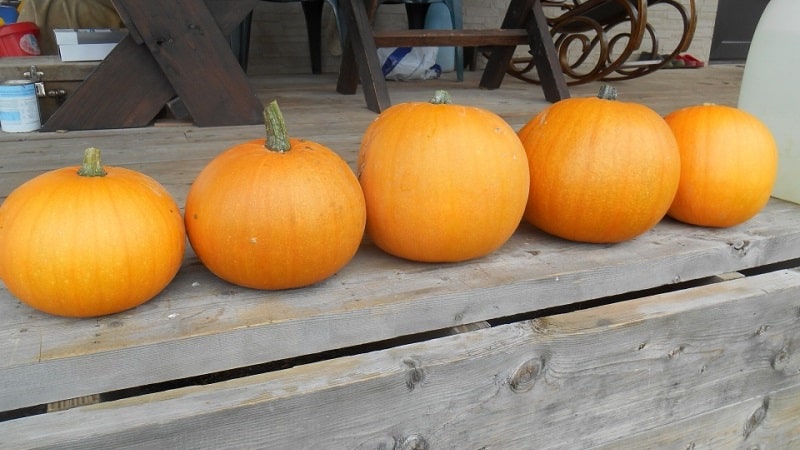
Pavel, Rostov-on-Don: “This variety is one of my favorites. The taste is moderately sweet, the flesh is pleasant. A rich harvest always grows. For example, last year I collected 15 kg".
Irina, Samara: “I planted the Orange Bush in the greenhouse. A week after planting, I noticed small bugs - slugs - behind the sprouts. We managed to get rid of them, but with difficulty. I think I will grow other varieties".
Conclusion
The round fruits with a honey aroma appeal to many summer residents. Growing does not require special skills, the main thing is to follow the rules of disinfection and care.To obtain a rich harvest, vegetables are planted in seedlings. Care involves regular watering and fertilizing. Orange pumpkins grow large, 5–7 kg. The harvest is harvested in August: some are used for cooking, some are put into the basement for storage.